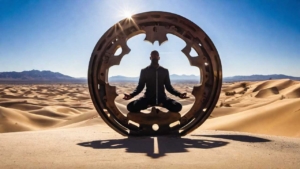‘Another Brick in the Wall (Part II)’ isn’t just a song; it’s a powerful statement on the problems with rigid education systems. Pink Floyd released this song in 1979 on their album ‘The Wall’, and it hits close to home for Roger Waters, the band’s bassist and main songwriter. He drew from his own life to criticize the way schools were squashing creativity and forcing kids to all be the same.
The song stands out musically, too—it includes a choir of kids, adding depth to its message about the struggles in school. People have talked a lot about this song because of how boldly it criticizes strict teaching methods. This has helped it become not just a hit on the charts, but also a rallying cry for those who feel education should nurture, not stifle, individuality.
As we discuss the layers of meaning in ‘Another Brick in the Wall (Part II)’, we see its lasting impact and how it’s become a key part of music that pushes for change.
‘In every classroom, there’s the hidden hope that each student’s spark won’t be smothered by the system.’
Song Context and Themes
‘Another Brick in the Wall (Part 2)’ by Pink Floyd serves as a scathing critique of the educational system, echoing a broader theme of resistance to oppressive authority within the rock opera album, The Wall.
The song embodies the rebellious spirit of the album, as it satirizes the rigidity and conformity enforced by academic institutions. With its iconic chorus, ‘We don’t need no education,’ the track challenges the notion of schooling as a mechanism for indoctrination rather than enlightenment.
As part of a triptych, this middle segment of ‘Another Brick in the Wall’ encapsulates the protagonist’s descent into isolation, symbolizing the emotional barriers constructed as a defense against systemic dehumanization.
Consequently, the song has resonated widely, becoming an anthem for those questioning the structures of power in education.
Composition and Production
The composition of ‘Another Brick in the Wall (Part II)’ introduces a distinctive fusion of rock and disco elements, meticulously crafted under the guidance of producer Bob Ezrin. Roger Waters’ lyrical vision was transformed into an anthem with a driving beat, which was a departure from Pink Floyd’s typical progressive rock sound.
The addition of a children’s choir from Islington Green School, whose vocals were layered to create a powerful collective voice, underscores the song’s thematic focus on the dehumanization of the education system. This innovative production choice added a haunting resonance to the track, enhancing its confrontational message.
Ezrin’s influence was pivotal, steering the band towards a sound that would leave an indelible mark on rock history.
Lyrics Analysis
Analyzing the lyrics of ‘Another Brick in the Wall (Part II)’ reveals a profound critique of the educational system’s impact on individuality and freedom. The song encapsulates a generational discontent with rigid schooling methods, using stark imagery and evocative language to underscore its message. Through its lyrics, the song communicates a sense of frustration and rebellion against an oppressive status quo that seeks to conform students to a particular mold.
- ‘We don’t need no education’ underscores the rejection of traditional schooling.
- ‘Teachers leave them kids alone’ highlights the desire for autonomy in learning.
- ‘All in all it’s just another brick in the wall’ suggests that each negative experience contributes to emotional barriers.
- ‘Thought control’ indicates a resistance to indoctrination and the loss of critical thinking.
Inspiration and Backstory
Roger Waters’ disdain for oppressive educational practices is deeply rooted in his own schooling experiences. Particularly, his time at the Cambridgeshire High School for Boys served as a direct inspiration for the lyrics of ‘Another Brick in the Wall (Part II).’ The song’s critical stance on the rigidity and conformity of academic institutions reflects Waters’ personal encounters with authoritarian teaching methods. He perceived these methods as stifling creativity and individual thought.
Waters’ lyrics advocate for a more nurturing approach to education. One that respects the individuality of each student rather than treating them as mere cogs in the machine. This powerful message is encapsulated in the song’s famous chorus, ‘We don’t need no education.’ It is a rebellious cry against the status quo of educational systems.
Chart Success and Accolades
Following its release, ‘Another Brick in the Wall (Part II)’ quickly climbed the music charts, securing the number one spot in multiple countries and earning Pink Floyd widespread acclaim. The track’s success was not just commercial but also critical, as it garnered a number of prestigious awards and recognitions that affirmed its impact on music and culture.
- Topped the UK Singles Chart and the U.S. Billboard Hot 100.
- Received a Grammy nomination for Best Performance by a Rock Duo or Group.
- Inducted into the Grammy Hall of Fame in 2010.
- Ranked #375 on Rolling Stone’s list of ‘The 500 Greatest Songs of All Time.’
Each accolade not only highlighted the song’s widespread appeal but also its significance as a cultural touchstone.
Controversy and Impact
Despite its commercial success, ‘Another Brick in the Wall (Part II)’ by Pink Floyd sparked significant controversy and had a profound impact on societal movements, particularly as an anthem in protests against rigid educational systems and political oppression. While the song resonated with many who shared a critical view of educational conformity, it also faced bans and was the subject of heated debates about its influence on youth. Its compelling message and widespread popularity underscored the power of music as a vehicle for social change.
| Controversy & Impact | Description |
|---|---|
| Banned in South Africa | Used as a protest anthem against apartheid. |
| Disliked by Thatcher | The UK Prime Minister reportedly took issue with its message. |
| Educational Criticism | Some educators felt it unfairly attacked teaching methods. |
| Symbol of Rebellion | Embraced by those opposing oppressive regimes. |
| Cultural Legacy | Remains a poignant reminder of the era’s social struggles. |
Frequently Asked Questions
How Did the Incorporation of a Children’s Choir in “Another Brick in the Wall (Part 2)” Influence the Perception of the Song in Academic and Educational Circles?
The inclusion of a children’s choir in ‘Another Brick in the Wall (Part 2)’ added a poignant contrast, highlighting the song’s critique of education and intensifying its message of youthful disillusionment with systemic schooling.
What Long-Term Effects Did the Song Have on the Personal Lives and Careers of the Children Who Participated in the Islington Green School Choir?
The song’s echoes in the Islington Green School choir members’ lives remain largely undocumented, with no clear evidence suggesting a significant long-term impact on their personal or professional trajectories.
How Have Modern-Day Educators and Students Interpreted the Song’s Message in the Context of Contemporary Education Systems?
Modern educators and students often interpret the song’s message as a critique of outdated teaching methods, advocating for personalized and critical thinking-based education over rigid, one-size-fits-all approaches.
In What Ways Has “Another Brick in the Wall (Part 2)” Been Utilized or Referenced in Psychological Studies or Discussions About the Effects of Institutionalized Education on Mental Health?
“Another Brick in the Wall (Part 2)” often serves as a metaphor in psychological discourse to explore the potential impacts of rigid educational systems on students’ mental health and individuality.
Has Roger Waters or Any Member of Pink Floyd Expressed Any Changes in Their Views of the Education System Since the Release of the Song, and if So, How Have They Articulated These Changes?
To date, Roger Waters has not publicly revised his stance on the education system as critiqued in “Another Brick in the Wall (Part II),” maintaining a consistent message on the issue.





Leave a Reply